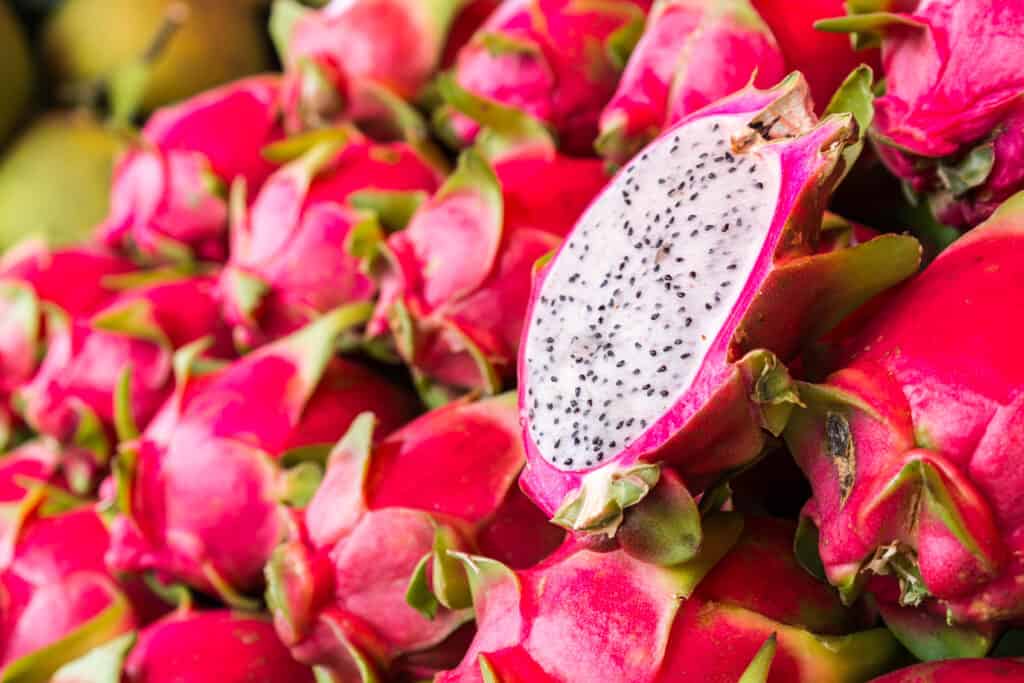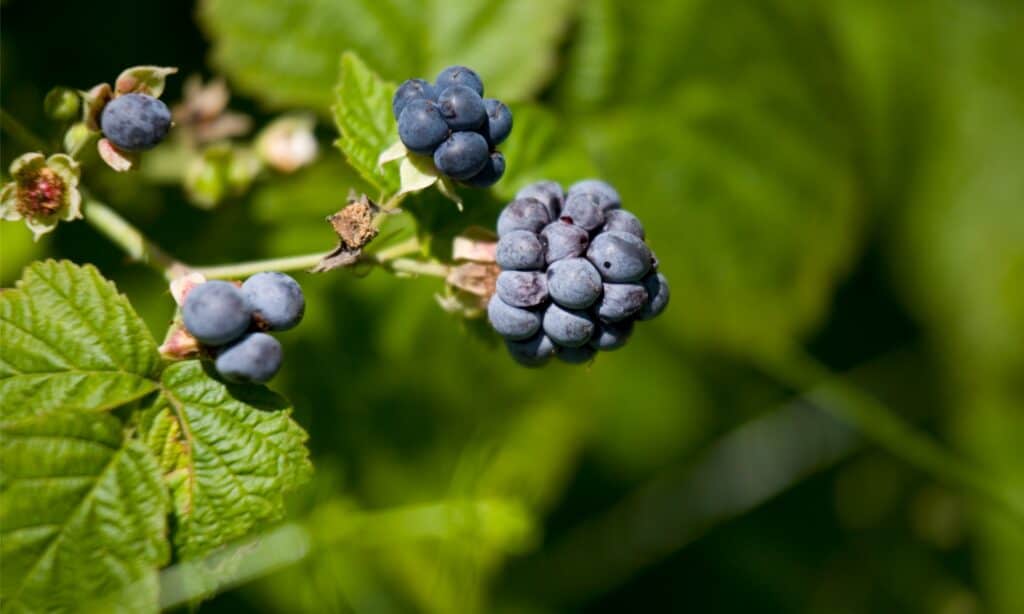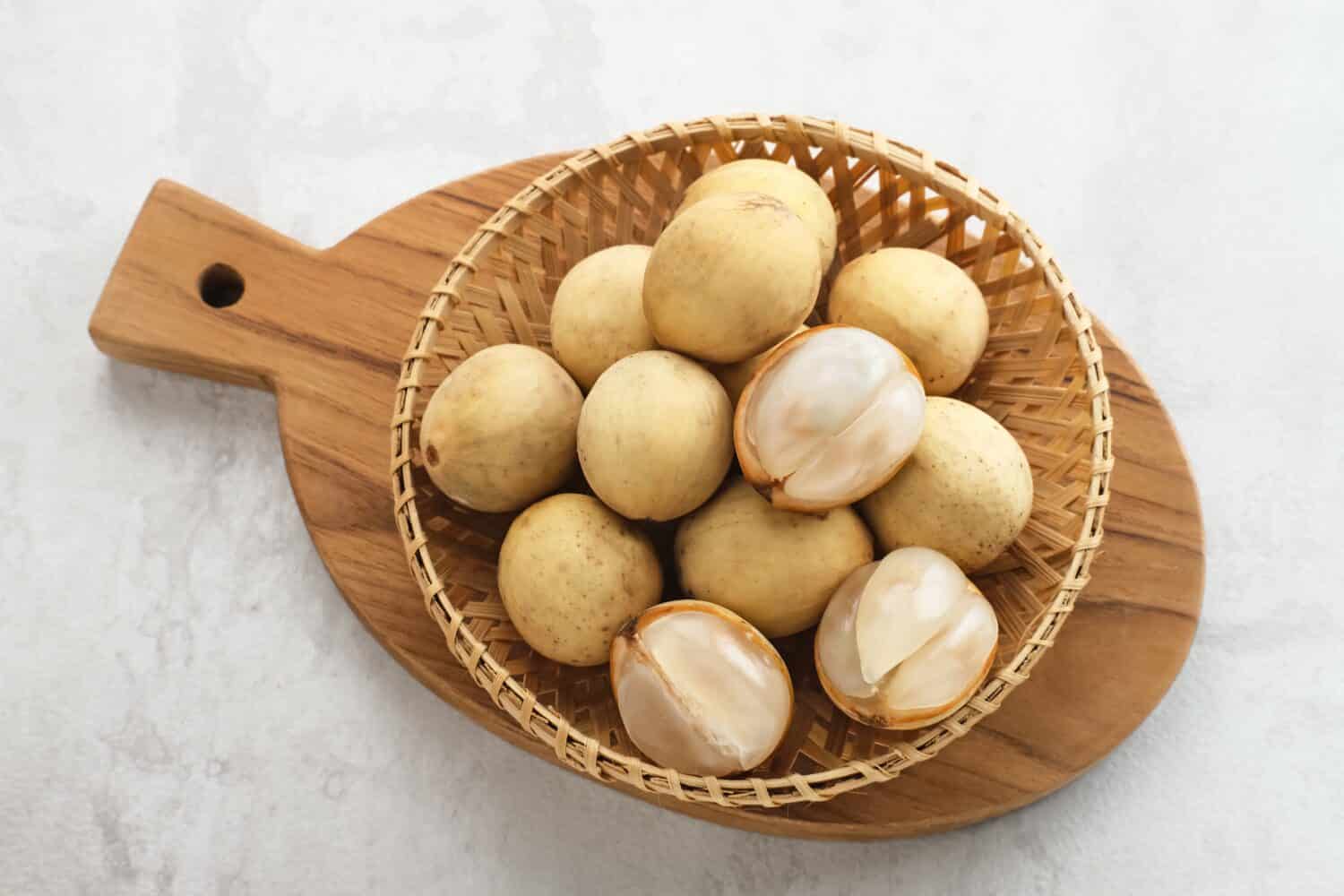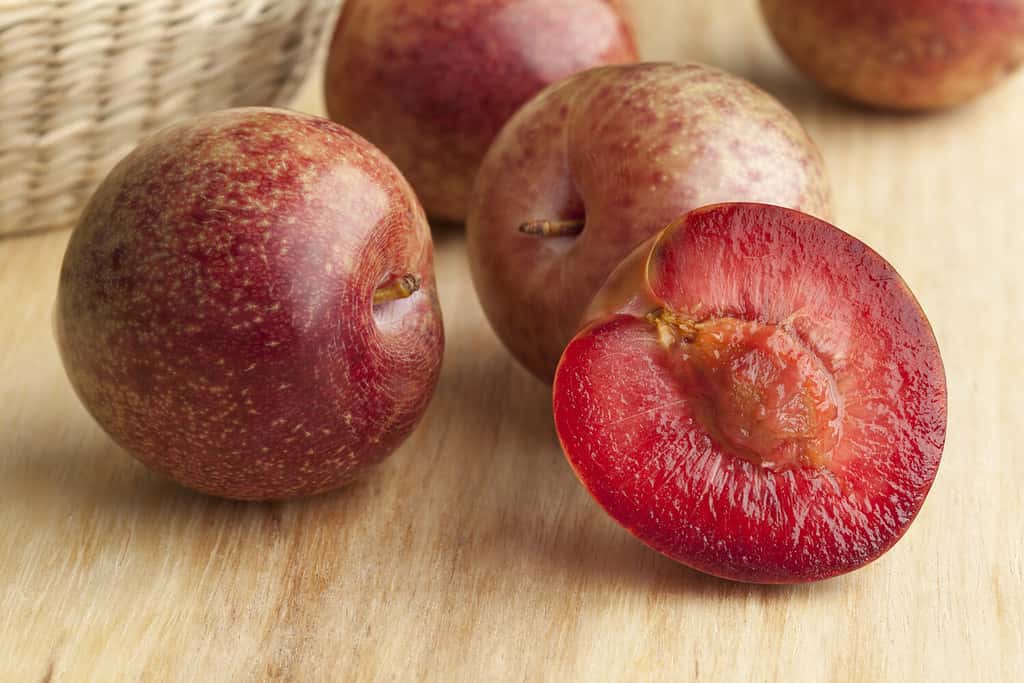Delicious, delectable, and downright nutritious—fruits that start with the letter D bring a delightful twist to your taste buds while packing a powerful punch of vitamins and minerals. In this juicy journey through the world of fruits, we’ll explore a dazzling array of fruits that start with D that deserves a spot on your plate.
1. Date

Dates are often referred to as “nature’s candy.”
©iStock.com/Volosina
Dates are small, sweet fruits known for their chewy texture and flavor that is similar to caramel. These delicious fruits are native to the Middle East and North Africa, where they have a long history of cultivation. Most of them are raised on farms in countries like Iran, Saudi Arabia, Morocco, and Egypt.
A blast of sweetness with nuances of honey and caramel greets you when you bite into a date. They are smooth and wrinkled on the outside and fibrous and thick on the inside. They are a pleasant natural delicacy because of their flavor, which is sometimes characterized as a mashup of butterscotch and brown sugar.
Dates may be used in a huge variety of dishes because of their incredible versatility. Stuffed dates, a traditional Middle Eastern meal, is one well-known illustration. Stuffed dates are pitted, and filled with toppings like almonds, cream cheese, or other fillings. They are then wrapped in bacon or pastry and baked. This combination of sweet and savory flavors is truly irresistible.
Also, dates are a key ingredient in many traditional desserts like date cakes, date bars, and date cookies. They are often used to sweeten smoothies and energy bars as a natural alternative to refined sugar. Dates also feature prominently in various savory dishes such as tagines, where they add a sweet and chewy contrast to the savory spices and meats.
Dates are not only a culinary delight but also a nutritious powerhouse, rich in essential minerals and fiber. Whether enjoyed as a snack on their own, incorporated into recipes, or used as a natural sweetener, dates continue to be cherished and savored worldwide for their unique taste and culinary versatility.
2. Dragon Fruit

These fruits are known for their colorful appearance.
©Pitchayarat Chootai/Shutterstock.com
Dragon fruit, also known as pitaya, is an exotic tropical fruit celebrated for its striking appearance and refreshing taste. It is native to Central America, specifically regions of Mexico. Dragon fruit has gained global popularity for its unique flavor and vibrant pink or yellow skin with green scales.
Dragon fruit’s flavor is sometimes compared to a mix between a kiwi and a pear. It has a gently sweet and softly tangy flavor, making it a refreshing choice for people looking for the taste of a rich tropical fruit. The fruit’s flesh has a melon-like feel with a little crunch that adds to its allure. It is also flecked with small black seeds.
Around the world, this fruit has been used in many different culinary concoctions. Simply cutting a dragon fruit in half and scooping out the flesh with a spoon allows you to enjoy it fresh. It’s a popular addition to fruit salads, lending its vibrant color and gentle sweetness to the mix. Dragon fruit can also be blended into smoothies, providing both flavor and visual appeal.
In addition to its use in sweet dishes, dragon fruit can be incorporated into savory recipes. Its mild sweetness can complement the flavors of salads and salsas, adding an interesting twist to traditional dishes. Some creative chefs even use it in seafood ceviche, where its refreshing taste pairs wonderfully with the acidity of lime and the richness of seafood.
Dragon fruit’s vivid appearance also makes it a favorite choice for garnishing desserts and cocktails. They add an exotic touch to the presentation of small dishes. Whether enjoyed on its own or as an ingredient in various dishes, dragon fruit’s delightful taste, and eye-catching appearance have made it a beloved addition to the global culinary landscape.
3. Durian

Durians are one of the largest fruits in the world.
©taveesak srisomthavil/Shutterstock.com
The very unusual tropical fruit known as durian is well known for its divisive flavor and strong scent. It is a fruit that is indigenous to Southeast Asia, including Malaysia and Indonesia. It is frequently referred to as the “King of Fruits.” The flavor of durian is an acquired taste; although some people find its aroma to be overbearing, others believe it to be a delicacy.
Durian is a fruit with a rich flavor profile. Common descriptions include custard-like sweetness with notes of vanilla, caramel, and almond. Its attraction is increased by the creamy, buttery feel. Despite the initial strong odor, many find the taste of durian to be surprisingly enjoyable.
In Southeast Asian cuisine, durian finds its way into various dishes and desserts. One popular preparation is durian sticky rice, where the fruit’s flesh is combined with sweet glutinous rice and coconut milk to create a rich and creamy dessert. Durian is also used in ice creams, shakes, and smoothies, blending its distinctive flavor with the sweetness of dairy products.
In addition to sweet dishes, durian can be incorporated into savory recipes. In Thai and Indonesian cooking, it’s sometimes added to curries or used as a filling for spring rolls.
Durian is also enjoyed fresh and ripe, with aficionados savoring its nuanced taste. The fruit’s divisive reputation often leads to strong opinions, with some people embracing its unique qualities while others steer clear due to the smell, which some liken to a mix of rotten onions and gym socks.
While durian’s aroma may be a barrier for some, its distinctive taste and cultural significance in Southeast Asia make it a captivating and polarizing fruit worth trying for adventurous eaters.
4. Dewberry

Dewberries are very similar to blueberries and raspberries.
©iStock.com/Bildvision_AB
The small, luscious dewberries are members of the Rubus genus and are linked to blackberries and raspberries. They are a well-liked wild berry that may be found in many places because they are native to North America and can grow in a range of temperatures.
Dewberries have a deliciously balanced flavor profile of sweetness and a little tartness. They are frequently likened to blackberries, however, they differ in that they have a slight acidity. The berries are renowned for their strong berry flavor, which intensifies as the fruit ripens. Dewberries deliver a rush of luscious sweetness right off the vine when they are fully ripe.
Dewberries are versatile and find their way into a range of culinary applications. Many people enjoy them fresh as a snack or added to fruit salads for their vibrant flavor and appealing texture. They can also be used in baking. They are often featured in pies, cobblers, and muffins, where their natural sweetness complements the baked goods’ richness.
One popular way to use dewberries is in the creation of preserves, jams, and jellies. Their high pectin content makes them ideal for setting into a thick, sweet spread that can be enjoyed on toast or as a topping for desserts. Dewberry jam is a favorite among those who appreciate homemade preserves.
5. Duku

These fruits contain lots of vitamin C.
©tyasindayanti/Shutterstock.com
Duku fruit, also known as langsat or lanzones, is a tropical gem cherished for its sweet and slightly tangy taste. Native to Southeast Asia, particularly Malaysia, Indonesia, and the Philippines, duku is a small, round fruit that grows in clusters on evergreen trees. Its unique flavor profile has made it a popular treat in the regions where it thrives.
The taste of duku is often described as a delightful blend of flavors. It offers a sweet and juicy pulp with subtle hints of citrus, making it both refreshing and satisfying. The fruit has a thin, leathery skin that is easy to peel, revealing the succulent segments inside. The texture is smooth and tender, with a few seeds that can be easily removed.
Duku fruit is commonly enjoyed fresh as a snack, with locals eagerly plucking the fruit from trees when it’s in season. It’s often found in local markets, where vendors sell them by the bunch. The fruit’s sweet and tangy flavor makes it a perfect addition to fruit salads, providing a burst of tropical goodness alongside other fruits like mangoes and pineapples.
In addition to being consumed on its own or in salads, duku is used to make refreshing beverages. The fruit can be blended into smoothies or squeezed to extract its juice, which is then sweetened and served chilled. This duku juice is a popular thirst quencher in Southeast Asia, especially on hot, sunny days.
Duku is also used in desserts and preserves. Some culinary enthusiasts incorporate it into jams, jellies, and sauces, adding a unique tropical twist to these sweet treats. It’s not uncommon to find duku-flavored candies and syrups in the region, showcasing its versatility as a flavorful ingredient.
6. Dwarf Banana

Dwarf banana plants make pretty good houseplants.
©silvia.cozzi/Shutterstock.com
The dwarf banana, also known as the “Dwarf Cavendish,” is a smaller type of banana plant that is highly regarded for its sweet and tropical flavor. These bananas are indigenous to Southeast Asia, specifically Malaysia, Indonesia, and the Philippines. Dwarf bananas are small and simple to grow, making them a favorite among home gardeners in contrast to their bigger relatives.
Dwarf bananas have a delicious flavor that combines sweetness with tangy undertones. They are frequently contrasted with Cavendish bananas, which are more widely available, but with a little stronger flavor and a smoother, creamier texture. Dwarf bananas are a favorite snack because, when fully ripe, they have a creamy, buttery quality that melts in your mouth.
Dwarf bananas are highly adaptable and may be used in a variety of dishes. They are frequently used in smoothies, where their inherent sweetness gives the drink a uniquely tropical flavor. To improve the flavor and give a creamy texture to cereal, yogurt, or oatmeal, these bananas can also be sliced and added.
In baking, dwarf bananas shine as well. They are a key ingredient in classic banana bread, muffins, and pancakes. Their sweet and moist flesh contributes to the overall richness of these baked goods. Mashed dwarf bananas can also be used as a natural sweetener and binder in recipes for healthier alternatives to traditional desserts, like banana-based ice cream or oatmeal cookies.
7. Desert Quandong

Desert quandong is indigenous to Australia.
©mastersky/iStock via Getty Images
Another entry on our list of fruits that start with D is the desert quandong. The desert quandong is a unique fruit indigenous to the arid regions of Australia, particularly in the central and southern parts. It is a small, round fruit with a tart and tangy flavor, and it has long been a vital part of Indigenous Australian culture and cuisine.
The taste of the desert quandong is a striking contrast to its vibrant red color. When ripe, the fruit is characterized by a sour and tangy flavor, often compared to a combination of cranberries and sour cherries. Its tartness makes it stand out in the world of fruits, and it can be eaten raw, although its flavor is most appreciated when used in culinary preparations.
In Indigenous Australian cuisine, the desert quandong is highly esteemed and used in various traditional dishes. One popular use is to make quandong jams, sauces, and chutneys. The tartness of the fruit lends itself well to these preserves, which can be enjoyed with meats, cheeses, or as a spread on bread.
Desert quandongs are also used in desserts and baked goods. They are a key ingredient in pies, tarts, and puddings, and their sharp flavor can balance the sweetness of sugar or other fruits. Some chefs incorporate quandongs into ice cream or sorbets, creating a unique and refreshing dessert option.
Apart from culinary applications, desert quandongs have been used for their medicinal properties in Indigenous cultures. They are believed to have healing properties and were used to treat various ailments. The fruits are rich in antioxidants and contain valuable nutrients like vitamin C.
8. Dinosaur Eggs

“Pluot” is another common name for the dinosaur egg fruit.
©Picture Partners/Shutterstock.com
The pluot, commonly referred to as the dinosaur egg, is a hybrid fruit that combines the traits of plums and apricots. This interesting fruit is renowned for its vivid, speckled look and distinctive flavor. Although they are not native to any one area, pluots are mainly grown in the United States, especially in California, where they were initially created.
The dinosaur egg or pluot fruit has a delicious flavor that combines a hint of apricot acidity with plum sweetness. They have rich, delicious meat with a smooth, velvety feel when they are fully ripe. Often referred to as a flavorful fusion of plum and apricot, pluots are prized for their richness of flavor, with certain cultivars favoring the flavor of one fruit over the other.
Pluots can be enjoyed in a variety of culinary creations. They are commonly eaten fresh, either as a standalone snack or added to fruit salads. This is where their vibrant, sweet-tart flavor enhances any overall fruit medley. Pluots may also be used to make jams and preserves, utilizing their inherent sweetness to produce mouthwatering spreads for desserts or toast.
Some inventive chefs play around with using pluots in savory recipes, adding them to salads and salsas to add a distinctive and surprising sweetness. The fruit is a favorite among people looking for unique flavors in their food because of its adaptability. This enables it to shine in both sweet and savory culinary applications.
Summary of Fruits That Start With D + More
| # | Fruit |
|---|---|
| 1 | Date |
| 2 | Dragon Fruit |
| 3 | Durian |
| 4 | Dewberry |
| 5 | Duku |
| 6 | Dwarf Banana |
| 7 | Desert Quandong |
| 8 | Dinosaur Eggs |
| 9 | Damson Plum |
| 10 | Dillenia |
| 11 | Diospyros |
| 12 | Donut Peach |
| 13 | Davidson’s Plum |
| 14 | Desert Date |
| 15 | Desert Lime |
| 16 | Damson |
| 17 | Desert King Fig |
| 18 | Decaisnea |
| 19 | Dekopon |
| 20 | Dabai Fruit |
The photo featured at the top of this post is © 9Witgiggs/Shutterstock.com
Thank you for reading! Have some feedback for us? Contact the AZ Animals editorial team.







